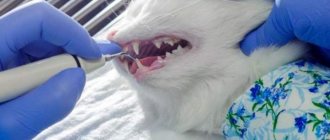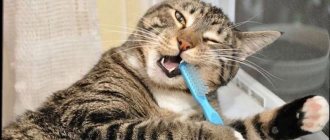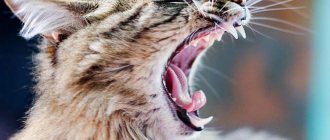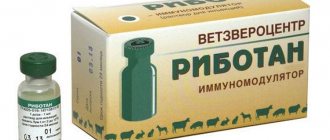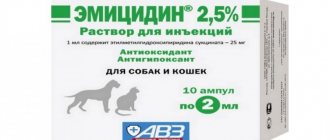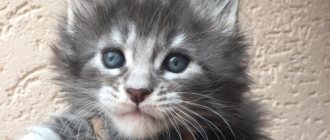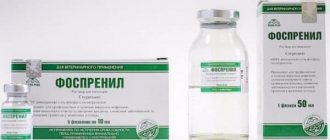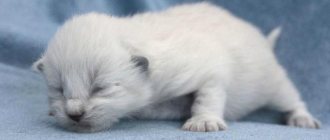Cats teeth
In most cases, kittens are born without teeth. There are exceptions to this rule, but they are extremely rare. At the age of 4-5 weeks, the kitten begins to cut its first teeth. The first set consists of 26 pieces (14 on the upper jaw and 12 on the lower jaw). As a rule, by two months the growth process is completed. By this time, healthy young cats can feed themselves and can be given solid food. They can also suckle from a cat; this usually does not cause discomfort to mothers.
Milk teeth are covered with white enamel, they themselves are sharp and quite thin. There are six incisors on the front of the jaws, followed by canines - one on each side. After them, premolars and molars grow, three on the lower jaw and two on the upper. The sequence of eruption is as follows: first the incisors appear, then the canines, and then the molars.
When the process of growth of the first, milk teeth is completed, the kittens are sent to a new place of residence (if the owner intends to do so). Before this, the first vaccinations are given and the necessary documents are completed.
It is necessary to sell or give away a kitten before the change of milk teeth to permanent ones begins.
Moving is stressful for an animal, and, in addition, during the process of replacing teeth, its body is weakened, so it is advisable to separate these two events in time. It is better for the animal if the shift begins when it has already become accustomed to its new place of residence and owners.
Treatment
If you notice that your cat’s teeth are falling out, and there are no natural reasons for this, then you urgently need to consult a veterinarian. The specialist will determine the cause, make a diagnosis, and prescribe treatment. As a rule, dentistry for cats consists of two parts. Firstly, these are procedures performed by a doctor in a veterinary clinic. Secondly, further care falls on the shoulders of the animal owner.
At the clinic, they can give you an intramuscular injection of antibiotics, give you special tablets for inflammation, and rinse your mouth with special solutions. In more complex cases, surgical operations are performed.
Changing teeth in kittens
At about 15-16 weeks of age, baby teeth begin to fall out and are replaced by molars. This happens in the same way as when the first set appears: first the baby teeth fall out and new incisors grow, then the lower, and then the upper canines, then the premolars and molars. The only difference is that in adult cats the full set consists of 30 teeth: 2 pieces are added on each jaw, 1 on each side.
The change process is completed at approximately seven months of age. Just like humans, cats have second molars that serve them throughout their lives. In order for them to be fully preserved in old age, the cat’s oral cavity must be properly cared for.
Internal diseases
Only a doctor can explain why a cat loses teeth at 5 years of age and at an older age. At this age, all dental problems in cats are pathological. There are many reasons that can cause tooth loss:
- violation of microflora in the oral cavity;
- caries (yes, cats also have it and very often);
- formation of tartar;
- pulpitis;
- periodontitis, etc.
Symptoms of tooth change
The owner may not notice the loss of incisors at first: they are very small. And cats are designed in such a way that they swallow small objects that end up in their mouths rather than spit them out. In addition, if the process goes well, then the kitten does not experience much discomfort and does not complain to the person.
The only normal symptom is itching of the gums, which the kitten tries to relieve by scratching them on something. During this period, wires, furniture, clothing, shoes and other things suffer. Also, teething is accompanied by copious salivation.
The appearance of permanent teeth occurs gradually. The root presses on the milky one, dissolving its weak roots in a few days. The top of the milky one falls out, and the root one begins to grow. During this period, the gums become slightly inflamed and swollen. When the permanent tooth erupts, it becomes normal.
During the period of teeth change, the kitten may show poor appetite, as it most likely experiences discomfort when chewing. In some cases, animals develop a short-term fever: the temperature rises slightly, and the cat tries to warm up, looking for warmer places.
It happens that the permanent tooth is already visible, but the milk tooth has not yet fallen out. If the latter does not interfere with the growth of the former, and the teeth do not injure the oral mucosa, then there is no need to worry. After some time, the milk will fall out. They normally do not harm each other, since they grow from separate holes.
Caring for a kitten during the period of teeth change
During the period of changing teeth, kittens' gums itch very much, just like people's gums (if adults remember this feeling). They try to chew on something to reduce the level of discomfort. At this time, owners need to be especially careful: the animal can harm itself, for example, by chewing electrical wires. There is also a danger of choking on a small object on which the kitten decided to scratch its gums. It is necessary to remove all such small items, wiring and other potentially dangerous things from the cat’s access area.
It is also necessary to pay attention to several issues: vaccination, nutrition and oral hygiene.
Nutrition
It is better to consult a veterinarian about the nutrition of a kitten during the period of teeth change. To build teeth, the animal’s body requires large amounts of calcium and phosphorus, so these elements can be slightly increased in the diet. However, you cannot overdo it: this is a serious burden on the kidneys. If parents or siblings had problems with the excretory system, then there is no need to introduce additional calcium and phosphorus.
If the kitten is accustomed to industrially produced food, then it should be fed dry food during this period. This will allow the pet to scratch its gums and, possibly, remove already loose teeth. There is no great danger in kittens swallowing teeth, but sometimes swallowed solids can harm the soft tissues of the digestive tract.
If the kitten has a natural diet, then it is recommended to give relatively large pieces of dietary meat. You can give fish twice a week, but you shouldn’t especially get used to such food. This is especially true for male kittens who are supposed to be castrated. In the future, fish will have to be completely excluded from the diet, and the animal should not get used to it.
You should also give your kitten plenty of dairy products rich in calcium. This can be cottage cheese, whole milk (if the animal tolerates it normally), yogurt, kefir with a low fat content.
In specialized stores you can find special bones that a kitten can chew on when its gums itch. In addition to the fact that it eliminates discomfort and helps teething, such products also contain useful additives that will improve the kitten’s health.
Vaccinations
Kittens should be vaccinated according to the schedule. The first vaccinations are given at two months; further procedures should be consulted with a veterinarian. As for vaccination during the period of teeth change, all veterinarians agree on this issue: while the milk teeth are falling out and the molars are growing, there is no point in getting vaccinated.
A visit to the veterinary clinic is stressful for the animal. And during the period of changing teeth, the kitten already feels somewhat weakened, even if everything is going fine. Therefore, vaccinations should be done before they begin to fall out, and then after the root ones grow.
Oral hygiene
To prevent tartar and other diseases of the oral cavity, teeth and gums, cats should brush their teeth regularly. Experts advise accustoming the animal to this procedure from infancy: then it will not experience discomfort, will get used to it and, perhaps, will even love cleaning.
Kittens need to brush their teeth with a special toothpaste and brush. Human toothpastes are not suitable for cats as they contain ingredients that are harmful to them. Each family member should have their own brush. There are also special gels for disinfecting the oral cavity for cats.
This should be done approximately once every three weeks. During the shift, you can purchase a special product containing anti-inflammatory and anesthetic components. Procedures with such a gel will significantly reduce the animal’s discomfort.
What if there are no teeth?
The digestive system of cats is more resilient than humans, and is designed in a slightly different way. If it is very important for us to chew every piece thoroughly, then cats do not have to do this. They need fangs and incisors only to capture and securely hold prey, and then tear it apart. Chewing is carried out with the help of molars, of which the cat has few.
Therefore, if we talk specifically about pets, then tooth loss is not as dangerous for them as for wild animals. The thing is that at home the cat does not experience any problems with lack of food.
But such animals still need care. You will have to switch your pet mainly to liquid or soft food. If this is not done, then digestive function will deteriorate significantly, and this can already threaten the development of a number of serious diseases.
Caring for a domestic cat is a whole complex of regularly performed actions. Caring for an animal helps it feel comfortable and safe around people. But not all owners know that the semantic content of the concept of “care” includes not only feeding, bathing and vaccinations. The health of the animal directly depends on how attentive its owner is to this issue.
In particular, oral disease is a common pathological phenomenon in cats. To independently determine whether a cat’s teeth are in order, you need to have a clear understanding of some of the features of its physiology. It is also important to know how many teeth a cat has, what structure they have, and how to properly maintain the microflora of the animal’s oral cavity in proper condition.
It’s not without reason that veterinarians advise taking a closer look at this part of the body in cats from early childhood, because they are reliable indicators of the cat’s general well-being. The occurrence of any disorders in the mouth indicates the course of the inflammatory process caused by the entry of pathogenic microorganisms into the body. The disease at the initial stage is quite difficult to determine, but by understanding what the ideal structure of the pet’s dental system should be, you can recognize the problem and immediately begin treatment, thereby preventing the likelihood of negative consequences.
In what cases is it necessary to contact a veterinarian?
The change of teeth occurs gradually, and it is necessary to regularly examine the kitten’s oral cavity. If the gums are pink, there is no inflammation or redness in the places where soft tissue joins the bone, and baby teeth do not interfere with the growth of permanent teeth, then there is no reason to worry. You should contact your veterinarian if you notice the following problems:
- there is redness around the baby tooth or the hole where it was located;
- pus appeared in the hole from the fallen tooth;
- a very strong unpleasant odor comes from the mouth;
- there is inflammation on the gums;
- the new tooth grows in such a way that it damages the mucous membrane, due to the fact that it is interfered with by the milk tooth or for another reason;
- The radical ones have grown, but the milk ones have not completely fallen out, and the shift time has ended.
You should also pay attention to the well-being and behavior of your pet. Warning signs:
- the kitten is apathetic, does not play;
- a plaintive meow, indicating serious discomfort and pain;
- the animal eats poorly or refuses to eat at all;
- anxiety, poor sleep.
Sometimes owners notice that the tray is empty for more than a day. This is also a cause for concern. The absence of bowel movements may be due to the fact that the kitten was trying to scratch its teeth and swallowed some object that blocked the intestinal lumen.
The owner should be aware that during the period of changing teeth, kittens' immune defenses are somewhat reduced, so changes in behavior may be due to the fact that the animal has contracted an infection. This can also happen to a kitten who lives in the house and is not outside. Owners can bring pathogenic flora into the apartment on shoes or clothes. Usually it is not dangerous for either animals or humans, however, against the background of a decrease in the immune status, the cat may get sick. Not everyone has been vaccinated by this age, and the animal does not have specific immunity to certain pathogens.
Peculiarities of tooth change in kittens of various breeds
During the selection process, many cat breeds acquire a lot of characteristics. One of them may be a non-standard course of teeth change. When purchasing a pet, you should consult with a specialist at the nursery or breeder about the various characteristics of the kitten.
In British and Scottish Fold kittens, the change of teeth is usually no different from this process in ordinary cats. In representatives of these breeds, quite often the permanent teeth begin to grow even before the milk teeth fall out. Especially often, similar problems in the British and Scots are observed with fangs. These are quite large teeth and it takes a relatively long period until the root of the milk tooth is worn off. When the native ones have already appeared, and the milk ones are firmly seated in the holes, and the situation does not change, you should take the kitten to the veterinarian. This should be done in case of inflammation, as well as in cases where the shift period has ended, but the dairy continues to remain in its place.
Thai and Siamese kittens often mature faster than other breeds, this is due to the small number of kittens in standard litters (usually 2-3). Their teeth may also change earlier. However, the canines of these breeds are somewhat thicker and longer than those of other cats, so they grow rather slowly.
Normally, these teeth can erupt between the ages of 4 and 6 months. This is absolutely normal, even if the milk precursor has fallen out a long time ago.
Sphinxes with a change of teeth fit within the generally accepted time frame. A delay can occur with fangs: both with the loss of milk teeth and with the eruption of molars. For representatives of this breed, as a rule, everything goes smoothly: first, the baby incisors fall out one by one, gradually being replaced by permanent ones. And then according to the standard scheme. In addition, the canines can be quite small, but this is a feature of the breed: these teeth can take up to a year to develop.
Maine Coons are large cats, and they mature quite late. Representatives of this breed are considered kittens until they are 15 months old, when other cats are already fully mature and mature. Therefore, the process of replacing baby teeth with permanent ones begins much later: molars can grow up to one year of age. It will not be very easy for the owner to deal with a Maine Coon during this period: he has a stormy temperament, forcing him to actively look for ways to get rid of the discomfort caused by the eruption of his molars.
Representatives of this breed, like no other cats, tend to chew furniture, shoes, wires, and children's toys.
Healthy kittens tolerate tooth changes easily, just like human children. Owners only need to take care of the safety of valuables, as well as regularly examine the pet’s oral cavity in order to promptly detect and solve possible problems.
